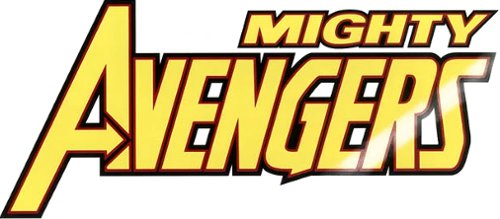BIOGRAPHY - Page 7
The new Starhawk possessed impressive might, serving as the Guardians’ powerhouse against foes like the Dread Dormammu and Doctor Doom. Aleta and Vance’s bliss was short-lived, though. Part of the power she received from the Hawk-God was a level of cosmic awareness which made Aleta “The One-Who-Knows,” at least in some fashion. Combining knowledge and power with little experience led her to drift further away from her humanity. The neophyte goddess 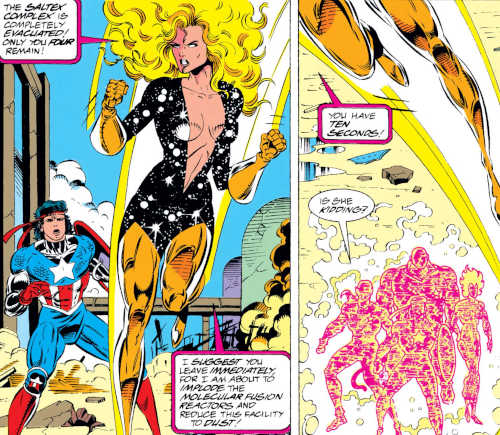 intended to prove herself self-sufficient from any man, particularly in Stakar’s shadow. The fact that she began to swear oaths “by her children’s coffins” made Aleta’s mental state even more concerning. Starhawk’s arrogance and independent streak made her as taxing as her predecessor to the team, and Major Victory struggled equally to command Starhawk as team leader and to get Aleta to acknowledge him as her fiancé once again. [Guardians of the Galaxy (1st series) #34-39]
intended to prove herself self-sufficient from any man, particularly in Stakar’s shadow. The fact that she began to swear oaths “by her children’s coffins” made Aleta’s mental state even more concerning. Starhawk’s arrogance and independent streak made her as taxing as her predecessor to the team, and Major Victory struggled equally to command Starhawk as team leader and to get Aleta to acknowledge him as her fiancé once again. [Guardians of the Galaxy (1st series) #34-39]
Starhawk’s over-confidence came back to haunt her when the Guardians joined Talon in liberating the reservation of Inhuman slaves on the moon. Loki, Asgardian God of Evil, was revealed as the secret ruler of the Inhumans, having cultivated a selective breeding program for centuries to produce elite Inhumans to help him conquer Asgard. Aleta ran off on her own to confront Loki when she sensed his presence, leaving the other Guardians behind. Loki’s lechery spurred Starhawk’s rage as they fought, but his magic and trickery overcame her still-growing understanding of her powers. On the Bifrost, Loki assumed Stakar’s visage to provoke Aleta into unleashing her power on the gates of Asgard, allowing his forces entry. He then banished Aleta 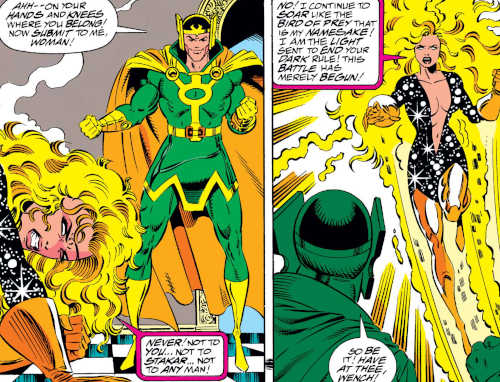 and the guardian Heimdall to imprisonment by the alien Remora. Starhawk reluctantly came to accept Heimdall’s aid in escaping the Remora, and her heart softened towards the noble Asgardian. Aleta continued to see herself as a goddess, however, and her affection for Heimdall was acceptable between equals. She remained distant and dismissive towards Vance and the other Guardians. [Guardians of the Galaxy (1st series) #40-43]
and the guardian Heimdall to imprisonment by the alien Remora. Starhawk reluctantly came to accept Heimdall’s aid in escaping the Remora, and her heart softened towards the noble Asgardian. Aleta continued to see herself as a goddess, however, and her affection for Heimdall was acceptable between equals. She remained distant and dismissive towards Vance and the other Guardians. [Guardians of the Galaxy (1st series) #40-43]
Working off of her own knowledge as the One-Who-Knows, Aleta commandeered the Guardians to take them back to Alpha Centauri IV, where they had left Yondu to tend to a lost tribe of his people. Instead, Yondu revealed his people were now a crossbreed of Centauri and Badoon as a result of the Guardians’ missives in the past. On Moord, Charlie had left behind a ceremonial dagger of Yondu’s, which led the Badoon to seek out Yondu’s people centuries earlier. This created a “time-jolt” where the Guardians were now living in an alternate timeline created by their own actions in the past. The full ramifications of this became clear as Yondu spoke of negotiating with Starhawk to return to the Guardians only if they corrected this travesty. Aleta and the others realized she had not yet assumed the mantle of Starhawk II when Yondu left them. With Yondu on Centauri was Stakar, the original Starhawk. [Guardians of the Galaxy (1st series) #44]
Exactly how Stakar returned to them is uncertain. The “time jolt” reality was apparently the next sequential reality in Stakar’s endless cycle which Aleta cast him into as an infant. The implication 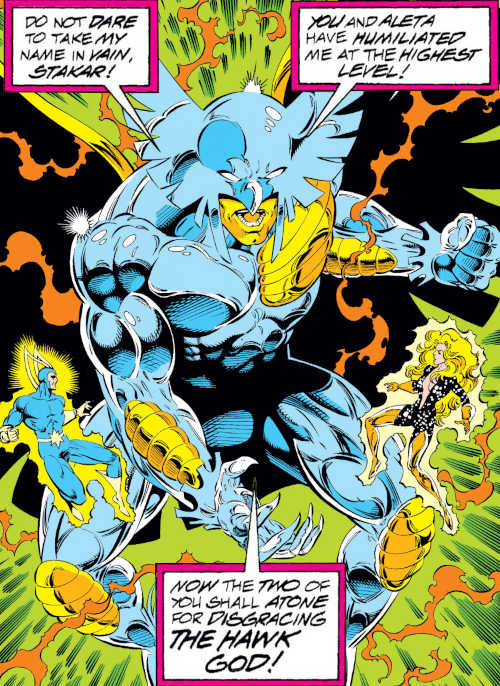 is that Stakar lived another full lifetime before meeting Aleta and the Guardians again in the present. Stakar was on Centauri IV as avatar of the Hawk God, on behalf of the greater cosmic forces of the universe. The Beyonder had entered the Guardians’ timeline and heedlessly engaged the Protégé, inadvertently ramping up the power curve of the young Magus exponentially. The Hawk-God was considered a renegade among the cosmic powers, condemned as the genocidal murderer of the Watchers and likely instigator of the prophesized War of the Cosmic Beings. He was sentenced to immobility on Arcturus for centuries after his trial and creating Starhawk after he awakened was meant in part to signal his “atonement.” Still, in the present era, Eternity and the Living Tribunal were willing to accept his aid and the aid of his avatars, provided Stakar and Aleta didn’t kill each other first.
is that Stakar lived another full lifetime before meeting Aleta and the Guardians again in the present. Stakar was on Centauri IV as avatar of the Hawk God, on behalf of the greater cosmic forces of the universe. The Beyonder had entered the Guardians’ timeline and heedlessly engaged the Protégé, inadvertently ramping up the power curve of the young Magus exponentially. The Hawk-God was considered a renegade among the cosmic powers, condemned as the genocidal murderer of the Watchers and likely instigator of the prophesized War of the Cosmic Beings. He was sentenced to immobility on Arcturus for centuries after his trial and creating Starhawk after he awakened was meant in part to signal his “atonement.” Still, in the present era, Eternity and the Living Tribunal were willing to accept his aid and the aid of his avatars, provided Stakar and Aleta didn’t kill each other first.
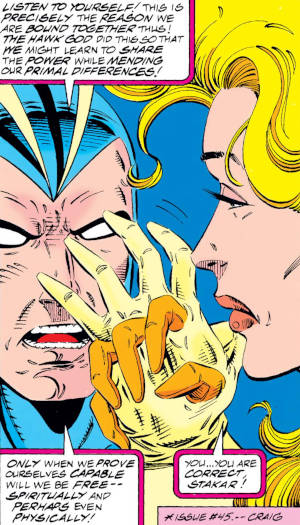 The Hawk-God appeared before his squabbling avatars over Centauri IV and put an end to their fighting. He forced the ex-spouses to work together by physically fusing their hands, leaving them unable to act alone. Aleta was livid but agreed to act as the Hawk-God wished in order to show that she remained worthy of his power. Stakar agreed to fulfill his promise to Yondu, and together the two avatars jaunted back in time to undo the “time jolt” reality. One thousand years ago on Moord, they discreetly incinerated the yaka dagger moments after the Guardians first departed, preventing the alternate future. Matters had escalated in their absence, as the cosmic powers prepared to judge the Beyonder and the Protégé in the Dimension of Manifestations, with the other Guardians drawn after them following a confrontation with Mephisto and Malevolence. Aleta was concerned about her comrades when they couldn't find them on Centauri, and pressed on to the Dimension of Manifestations. The Hawk-God was embarrassed by the sudden arrival of his step-children disrupting the proceedings, and he stripped his power from both Aleta and Stakar in a show of discipline. The Guardians joined forces with the Beyonder to defend the cosmic powers against a tantrum from the Protégé. The omnipotent child was undone, and sealed away by cosmic judgment of the Living Tribunal.
The Hawk-God appeared before his squabbling avatars over Centauri IV and put an end to their fighting. He forced the ex-spouses to work together by physically fusing their hands, leaving them unable to act alone. Aleta was livid but agreed to act as the Hawk-God wished in order to show that she remained worthy of his power. Stakar agreed to fulfill his promise to Yondu, and together the two avatars jaunted back in time to undo the “time jolt” reality. One thousand years ago on Moord, they discreetly incinerated the yaka dagger moments after the Guardians first departed, preventing the alternate future. Matters had escalated in their absence, as the cosmic powers prepared to judge the Beyonder and the Protégé in the Dimension of Manifestations, with the other Guardians drawn after them following a confrontation with Mephisto and Malevolence. Aleta was concerned about her comrades when they couldn't find them on Centauri, and pressed on to the Dimension of Manifestations. The Hawk-God was embarrassed by the sudden arrival of his step-children disrupting the proceedings, and he stripped his power from both Aleta and Stakar in a show of discipline. The Guardians joined forces with the Beyonder to defend the cosmic powers against a tantrum from the Protégé. The omnipotent child was undone, and sealed away by cosmic judgment of the Living Tribunal.
 Once order was restored, the Hawk-God acted magnanimous before Eternity and the Living Tribunal and declared the trials of Aleta and Stakar were over, and he would graciously repower his chosen avatar as Starhawk. Aleta retracted her name from consideration, for she had come to recognize how the Hawk-God’s power distanced her from matters of the heart. She would not sacrifice her empathy for strength again. Aleta addressed Stakar and told him their love could never be again, but she had finally put her anger behind her and forgiven him for his past misdeeds. The Hawk-God agreed to name Stakar as Starhawk once more. As an added boon, he allowed Aleta to retain an augmented version of her previous powers as she returned to the Guardians of the Galaxy. Once they were alone, however, the capricious Hawk-God mocked his avatar, informing Stakar for the first time that the Arcturian Mutants he thought were his parents were, in fact, not. He cruelly jibed at “The One-Who-Knows” for not knowing this basic fact, leaving Starhawk haunted and bound into his service once more. [Guardians of the Galaxy (1st series) #45-50]
Once order was restored, the Hawk-God acted magnanimous before Eternity and the Living Tribunal and declared the trials of Aleta and Stakar were over, and he would graciously repower his chosen avatar as Starhawk. Aleta retracted her name from consideration, for she had come to recognize how the Hawk-God’s power distanced her from matters of the heart. She would not sacrifice her empathy for strength again. Aleta addressed Stakar and told him their love could never be again, but she had finally put her anger behind her and forgiven him for his past misdeeds. The Hawk-God agreed to name Stakar as Starhawk once more. As an added boon, he allowed Aleta to retain an augmented version of her previous powers as she returned to the Guardians of the Galaxy. Once they were alone, however, the capricious Hawk-God mocked his avatar, informing Stakar for the first time that the Arcturian Mutants he thought were his parents were, in fact, not. He cruelly jibed at “The One-Who-Knows” for not knowing this basic fact, leaving Starhawk haunted and bound into his service once more. [Guardians of the Galaxy (1st series) #45-50]
Back with the Guardians, Aleta found new uses for her light-construct powers and could even fly on her own now. However, she and Vance remained star-crossed lovers. While Aleta’s emotional detachment was gone, Major Victory had fought Mephisto and lost the preservation spell which allowed him to live outside his containment suit. A strange black undergarment gifted to him by the Beyonder had saved his life, reforming around him at the moment of the counter-spell to preserve 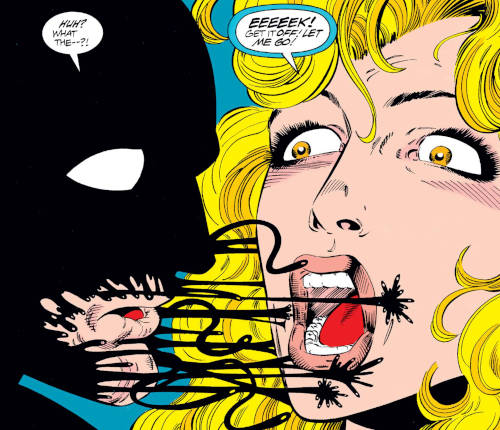 his flesh, but he was once again trapped in this version of his old suit. Moreover, the new containment suit sometimes responded as if it were alive. When Vance attempted to retract the suit partially to show Aleta they could still kiss, the suit began extending onto her in a way she found revolting. Their romance could not continue until the suit was dealt with, and their relationship became cold and professional in the field. [Guardians of the Galaxy (1st series) #51]
his flesh, but he was once again trapped in this version of his old suit. Moreover, the new containment suit sometimes responded as if it were alive. When Vance attempted to retract the suit partially to show Aleta they could still kiss, the suit began extending onto her in a way she found revolting. Their romance could not continue until the suit was dealt with, and their relationship became cold and professional in the field. [Guardians of the Galaxy (1st series) #51]
The Guardians of the Galaxy had an extended mission where Charlie-27 was framed for being the interplanetary serial killer, Ripjak. The Guardians forcibly extracted him from the Stockade prison and tracked Ripjak to Mars, the quarantined fourth planet ever since the invasion of Earth a 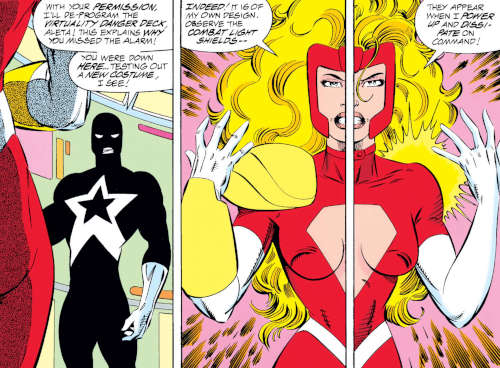 millennia ago. They learned in turn that Ripjak was the last Martian, a bio-engineered scientist whose world fell to a plague centuries ago. Ripjak was actually a mercy killer, tracking the cosmic plague-bringer known as Bubonicus and euthanizing worlds he could not save from Bubonicus’ lingering but lethal work. Aleta found several reasons to revisit her Arcturian heritage during this mission, for the daughter of Ogord had sway over the Interstellar Transgression Triumvirate overseeing Stockade.
millennia ago. They learned in turn that Ripjak was the last Martian, a bio-engineered scientist whose world fell to a plague centuries ago. Ripjak was actually a mercy killer, tracking the cosmic plague-bringer known as Bubonicus and euthanizing worlds he could not save from Bubonicus’ lingering but lethal work. Aleta found several reasons to revisit her Arcturian heritage during this mission, for the daughter of Ogord had sway over the Interstellar Transgression Triumvirate overseeing Stockade.
The Ripjak mission was a breaking point for the team, though. While the last Martian Master was not strictly their enemy, his species was responsible for nearly wiping out the human race. Many Guardians had trouble putting aside their animosity towards Ripjak when Major Victory decided they should share data towards defeating the greater threat of Bubonicus. Aleta was seriously injured in their first ruckus when Ripjak drained her living light to analyze it, and only Yondu’s empathic mysticism helped her to recover. The Guardians’ Inhuman member Talon had mutated 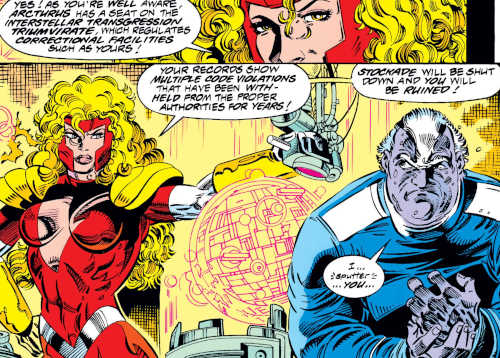 recently, and his exaggerated pack dynamics made him constantly insubordinate towards Major Victory. When circumstances conspired to have Major Victory leave the Guardians behind to pursue Bubonicus with Ripjak and the High Evolutionary, Talon seized the moment to call for a vote of no-confidence in Vance’s leadership. Major Victory returned to discover the Guardians had quit the Guardians' ship, seemingly leaving him alone. Only Aleta remained – she hoped that time away from the team would allow them to rekindle their romance and work on ways of dealing with Vance’s exo-suit. [Guardians of the Galaxy (1st series) #52-58]
recently, and his exaggerated pack dynamics made him constantly insubordinate towards Major Victory. When circumstances conspired to have Major Victory leave the Guardians behind to pursue Bubonicus with Ripjak and the High Evolutionary, Talon seized the moment to call for a vote of no-confidence in Vance’s leadership. Major Victory returned to discover the Guardians had quit the Guardians' ship, seemingly leaving him alone. Only Aleta remained – she hoped that time away from the team would allow them to rekindle their romance and work on ways of dealing with Vance’s exo-suit. [Guardians of the Galaxy (1st series) #52-58]
After months of testing, Vance and Aleta confirmed his exo-suit was not a symbiote from the Beyonder as they feared. Instead, it was merely a sympathetic exo-armor responding to Major Victory’s ionically-enhancing powers. The Guardians regrouped on a shocking mission to travel back in time and prevent the War of the Worlds, ending the Martian invasion of Earth from a thousand years ago before it even occurred. They were successful, for what it’s worth, though the long-term temporal ramifications of another probable “time jolt” went unexplored. A renegade Inhuman named Wormhole with a grudge against the Guardians cast a fractal tunnel in their path as they re-entered the timestream to return to the 31st century. The Icarus ended up crashing on an unknown world, in an unknown reality, at an unknown point in time. [Guardians of the Galaxy (1st series) #59-62]
The final fate of Aleta and the Guardians of the Galaxy is unknown. Whether they eventually returned to their 31st century home as it was, or found it horribly changed, has not been chronicled. They reappeared only briefly after the War of the Worlds mission, revisiting the 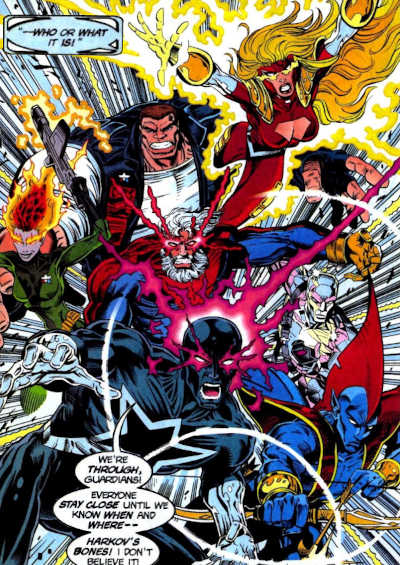 divergent timeline of Earth-616 created by Vance’s interaction with his own past self. Vance Astro and the Guardians discovered an unstable temporal anomaly among the New Warriors, the team led by young Vance Astrovik, now known as Justice. Aleta’s team disappeared in a temporal inversion as the anomaly attempted to cover its tracks, editing events so that the Guardians never arrived in the first place. [New Warriors (1st series) #68]
divergent timeline of Earth-616 created by Vance’s interaction with his own past self. Vance Astro and the Guardians discovered an unstable temporal anomaly among the New Warriors, the team led by young Vance Astrovik, now known as Justice. Aleta’s team disappeared in a temporal inversion as the anomaly attempted to cover its tracks, editing events so that the Guardians never arrived in the first place. [New Warriors (1st series) #68]
Meanwhile, Stakar was sufficiently provoked by the Hawk-God’s taunts to begin a quest to understand his own origins. [Guardians of the Galaxy (1st series) #54] He sought out Hollywood, the thousand-year-old Wonder Man, for his insight. Simon suggested Starhawk speak with Norrin Radd, the former Silver Surfer, who was now serving as the Keeper and Protector of the Universe. Hollywood had little love for Norrin – while Simon was teleported away from Earth against his will during the Martian invasion, the Silver Surfer willingly left after Eon instructed him to do so. Still, his lifetime of experience with cosmic matters might be of use to Starhawk. [Guardians of the Galaxy (1st series) #57]
Starhawk found the Keeper severely injured after a spat with Galactus. He used his powers to begin healing Norrin Radd of his wounds, but openly pondered whether the Keeper’s Quantum Bands might hold answers he needed. The Protector of the Universe’s patron Eon manifested himself to chastise Stakar for thinking of taking the bands for selfish gain, lamenting on how disciples of the Hawk-God could never be trusted. Eon attempted to de-age Stakar and send him  into the next re-incarnation of his life cycle, but The One-Who-Knows resisted his influence and steadied himself. Eon surprisingly chose to give Stakar what he wanted then, bestowing the Quantum Bands on Stakar from the prone form of the Keeper. Contact with the Bands awakened within Starhawk some knowledge of previous wielders, as Eon revealed to Starhawk that his biological father was Wendell Vaughn, the Earthman known as Quasar. [Guardians of the Galaxy (1st series) #58-59]
into the next re-incarnation of his life cycle, but The One-Who-Knows resisted his influence and steadied himself. Eon surprisingly chose to give Stakar what he wanted then, bestowing the Quantum Bands on Stakar from the prone form of the Keeper. Contact with the Bands awakened within Starhawk some knowledge of previous wielders, as Eon revealed to Starhawk that his biological father was Wendell Vaughn, the Earthman known as Quasar. [Guardians of the Galaxy (1st series) #58-59]
Using the power of the Hawk-God and the Quantum Bands, Starhawk divined the location of his father’s grave and learned Quasar’s fate as a victim of the Abrogate. The intoxicating power led Stakar to defy Eon and the Keeper in an effort to keep the Bands. The Keeper used his greater knowledge of the Bands’ power to retrieve them from the thief before dispatching Starhawk on to the Abrogate. At the galactic hub, the Abrogate stood as a sentient confluence of matter and anti-matter, a foe which even Starhawk’s power could not defeat. Stakar was annihilated by the Abrogate, but his brief contact with the Quantum Bands meant that his soul made contact with the White Room, final destination for all previous Protectors of the Universe. It was here that Stakar met the shade of his father, Wendell Vaughn.
Treading carefully, Stakar did not reveal their connection to Wendell. The shade of Quasar lamented how the War of the Worlds may have been lost because he left at a critical moment. Stakar learned how Quasar got his pregnant lover Kismet to Vesper and the intergalactic Sisters 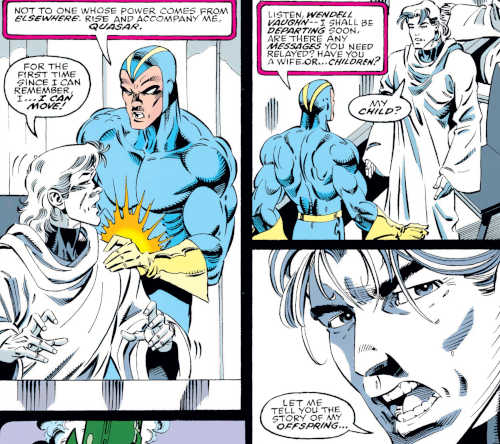 of Mercy during the Martian invasion, but his fight with the Abrogate on the way back claimed his life. Believing that Earth fell because of his failure to return, Quasar claimed he didn’t deserve to know his offspring’s fate. Stakar quietly chose to honor his father’s request but refused to remain indefinitely in the White Room. As a vessel for power outside of Eon’s, Stakar was not bound to the White Room as others were. He blasted free and returned to the physical plane. (Behind him, Wendell Vaughn
of Mercy during the Martian invasion, but his fight with the Abrogate on the way back claimed his life. Believing that Earth fell because of his failure to return, Quasar claimed he didn’t deserve to know his offspring’s fate. Stakar quietly chose to honor his father’s request but refused to remain indefinitely in the White Room. As a vessel for power outside of Eon’s, Stakar was not bound to the White Room as others were. He blasted free and returned to the physical plane. (Behind him, Wendell Vaughn 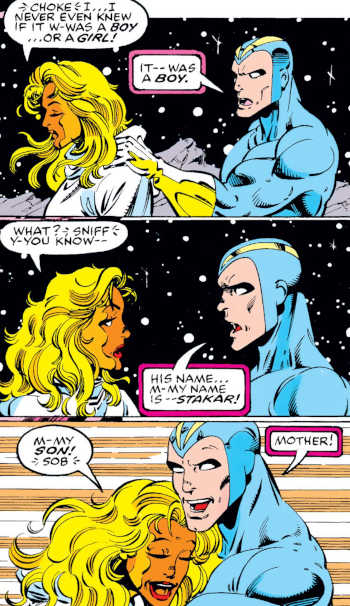 conferred with Eon and revealed they both knew the truth about who Starhawk was to him, but concealed that from Stakar for unknown reasons. Specifically, Wendell conferred with the REAL Eon.)
conferred with Eon and revealed they both knew the truth about who Starhawk was to him, but concealed that from Stakar for unknown reasons. Specifically, Wendell conferred with the REAL Eon.)
On the final leg of his journey, Starhawk visited Vesper and found Kismet still living there at the nunnery after all these centuries. He shared with her the final fate of Quasar and revealed his identity, leading to a joyful reunion between mother and son. As Kismet angrily explained how Eon stole her son moments after his birth, “Eon” arrived and revealed the truth. The real Eon was dead and inhabited the White Room with Quasar and other past wielders, while her child, Era, had been posing as Eon for more than a thousand years. It was Era who tricked the Silver Surfer into leaving Earth to the Martians and diverted Quasar to the Arbogate rather than allowing him to return to the fight. Era had a warped dream of instituting cosmic instability and had been working against the higher powers for longer than anyone realized. Starhawk and Kismet joined forces to drive off the mad cosmic entity, and the Hawk-God emerged in his wake.
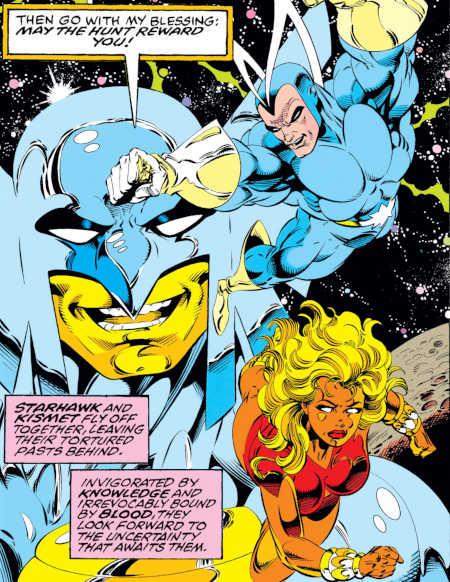 The Hawk-God explained his reasons for sending Stakar on this quest were meant to guide him into uncovering Era’s insane plotting. Era sought to engineer an “ultimate calamity,” and was responsible for framing the Hawk-God for orchestrating the War of the Cosmic Beings in order to obscure his own machinations. Stakar was still furious at being manipulated into these revelations. He and Kismet chose to pursue Era to gain revenge for Quasar’s death, and not out of any allegiance to his patron. The Hawk-God laughingly accepted the independent spirit of his chosen avatar, and wished mother and son the best as they departed on their quest. [Guardians of the Galaxy (1st series) #60-62]
The Hawk-God explained his reasons for sending Stakar on this quest were meant to guide him into uncovering Era’s insane plotting. Era sought to engineer an “ultimate calamity,” and was responsible for framing the Hawk-God for orchestrating the War of the Cosmic Beings in order to obscure his own machinations. Stakar was still furious at being manipulated into these revelations. He and Kismet chose to pursue Era to gain revenge for Quasar’s death, and not out of any allegiance to his patron. The Hawk-God laughingly accepted the independent spirit of his chosen avatar, and wished mother and son the best as they departed on their quest. [Guardians of the Galaxy (1st series) #60-62]
